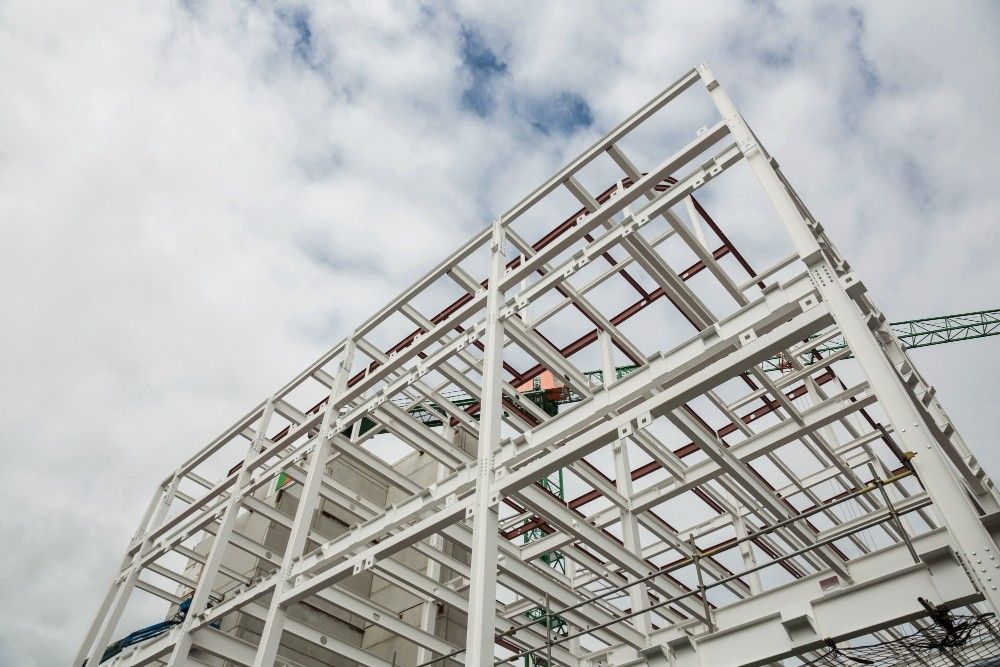
Steel vs. RCC in Non-Industrial Buildings: A Comparative Analysis
Steel construction has been gaining immense popularity as an alternative to traditional reinforced concrete, also known as RCC, construction in non-industrial buildings. Steel construction offers an array of benefits over traditional reinforced concrete cement construction, including quicker construction times, enhanced durability, and greater design flexibility.
In this article, we will explore the advantages and disadvantages of steel construction for non-industrial building structures and how it fares compared to traditional RCC construction.
Benefits of Steel Construction Over Reinforced Concrete and Cement Construction
As learned, steel construction offers several advantages over the traditional practice of RCC construction. Let us look at its advantages.
Faster Construction Times
One of the most significant benefits of steel construction over traditional RCC construction is its faster construction times. Steel structures can be prefabricated off-site and assembled at a quicker pace, significantly minimising the construction time. The prefabrication process also ensures that the quality of the pre-engineered steel structure is consistent and meets the required standards, leading to fewer delays and reduced construction costs.
Improved Durability
Steel structures are highly durable and capable of withstand harsh environmental conditions and the designed load effectively. Steel is resistant to corrosion and is not affected by termites, unlike wood. Additionally, steel has a high strength-to-weight ratio, making it more resistant to calamities like earthquakes, hurricanes, and other natural disasters.
Greater Design Flexibility
Steel construction enables greater design flexibility, allowing architects and designers to craft unique and complex structure designs that are difficult to achieve with traditional RCC construction. Steel structures can be designed in various shapes and sizes, and their modular nature enables easy expansion and modification if required. Lower maintenance costs Steel structures require less maintenance than traditional concrete structures. Unlike traditional concrete structures, which require periodic maintenance, steel structures require minimal maintenance, reducing long-term maintenance costs.
Disadvantages of Steel Construction
Steel structures, on the other hand, have some demerits too. Let us study the disadvantages of steel construction.
Higher Initial Costs
One of the biggest demerits of steel construction is its high initial cost compared to traditional RCC construction. Steel structures require a higher upfront investment due to the cost of the raw materials, specialised equipment, and labour to be deployed for construction. However, this cost can be offset by the faster construction times, reduced maintenance costs, and improved durability of steel structures.
Fire Hazards
In construction, steel is a highly conductive material, making it susceptible to fire hazards. However, this can be addressed through fireproofing measures, such as applying fire-resistant coatings to the steel elements or using fire-resistant insulation.
Noise Pollution
Steel structures can generate more noise pollution than traditional concrete structures. Steel structures transmit sound vibrations more efficiently than reinforced concrete structures, making them less suitable for buildings that require sound insulation, such as hospitals or schools.
How Steel Construction Compares to Traditional RCC Construction?
Strength and Durability
Steel structures have a higher strength-to-weight ratio than conventional structures built using RCC, making them more resistant to earthquakes, hurricanes, and other natural calamities. Steel structures also have a longer lifespan than concrete structures, as they are resistant to corrosion and termites.
Construction Time
Steel construction is quicker than traditional RCC construction. Steel structures can be prefabricated off-site and assembled at a faster rate, ensuring time and cost efficiency.
Design Flexibility
Steel construction allows for greater design flexibility than RCC construction. Steel structures can be designed in various shapes and sizes, and their flexible nature allows for easy expansion and modification if needed.
Initial and Maintenance Costs
Steel construction has a higher initial cost than RCC construction due to the cost of the resources like raw materials, specialised equipment, and labour required for construction. However, this cost can be reduced by the quicker construction times, reduced maintenance costs, and enhanced durability of steel structures. Steel structures require less maintenance than traditional RCC structures, reducing long-term maintenance costs.
Wrapping Up
Steel construction is a viable alternative to traditional concrete construction for non-industrial buildings. Steel structures offer a number of benefits, including faster construction times, enhanced durability, and greater design flexibility. However, steel construction also has its disadvantages, including higher initial costs, fire hazards, and noise pollution. But the benefits of steel construction for non-industrial buildings outweigh its advantages. Hence, steel construction is highly preferred for the construction of non-industrial buildings.





